My cousin is a Jazz pianist. Sometimes I envy him. I am sitting the whole day in front of the computer, coming up with elegant code, intricate game design mechanics and laboriously squeezing every pixel in Photoshop to communicate the desired message, and people will still have such hard time recognizing the value of that work. Meanwhile, he can casually walk up to a piano, sit down and spontaneously create a tune which everybody in a room will instantly understand as “art” and something worth spending time listening to. Maybe this is why I am a bit suspicious when it comes to music, especially music in games. Not that I don’t like music, I do! I especially like my cousin’s music too! I just sometimes find myself thinking I am the only sane person in the world, who does not make such a big deal out of it.
My cousin, Marcin Masecki, doing his thing.
Here are three important facts about music and what is can and cannot do in games:
Music is great for setting a mood
Seriously, nothing sets a mood as good as a piece of music does. A painter can create the most striking, disturbing image, a poet can write the most gloomy, dark poem. Then, just play Yakkity Sax in the background and all that angst turns into comedy in an instant. And it works the other way around too! Rammstein vs. Teletubbies. Will it feel bright and cheerful like the Tetubbies? I don’t think so.
I learned that lesson when working on the Twisted Reality project. We had some bizarre videos of flying buildings and we had to make a music video out of it. Some people in the project insisted in this dark and gloomy soundtrack. I resisted because people would immediately interpret those buildings as a threat which would take away the mystery. The other team members were convinced you could counter-balance that with post-processing and cutting. So we kept the gloomy soundtrack and you can see who was right in the end.
This is great news for game designers because you can create awesome experiences with so little effort. Maybe you don’t need to spend so much time in those photorealistic, normal-mapped, anti-aliased, carefully lit, laboriously textured, environments when simple 2D sprites and some great piece of music can do the job. I am reminded of “The Crowd” by Kyle Gabler from the Experimental Gameplay Project. When this weird people start to sing I always get the goosebumps.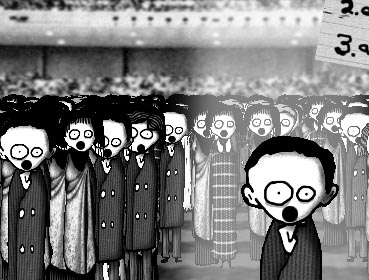
The people in “The Crowd” look already a bit creepy, but when they start singing…
Music is a system
That seems like something obvious but it can be (and has been) used by game designers to link music to game mechanics. Music is something quite logical. There is rhythm, there are distinct notes, there are tones, which have a mathematical relationship with each other. By just following some simple rules, you can take any kind of sound and make something out of it which will be perceived as music. Games like Electroplankton or Everyday Shooter are great examples of understanding music as a system. But even Guitar Hero uses the rhythm of music to augment gameplay.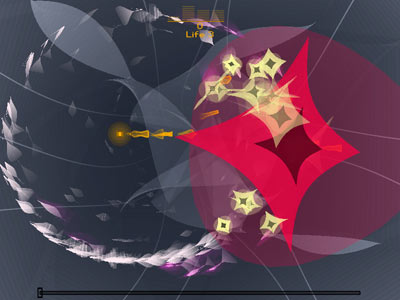
Here is Everyday shooter, blurring the boundary between sound effects and music like it’s nothing.
Music is not a language
You hear it always especially form jazz musicians (take that, dear cousin ![]() . “Music is like a language but without words so you can communicate across cultural boundaries”. No it isn’t and no you can’t. This is just poor understanding of what a language is. Put down that instrument and go read a book about linguistics. There has been a tremendous amount of research about language and it is still a phenomenon with lots of unsolved problems. But so far it seems like all languages actually share some common features and although music exhibits some of them, it fails to satisfy the criteria entirely. When you compare music to a language it just shows how ignorant you are.
. “Music is like a language but without words so you can communicate across cultural boundaries”. No it isn’t and no you can’t. This is just poor understanding of what a language is. Put down that instrument and go read a book about linguistics. There has been a tremendous amount of research about language and it is still a phenomenon with lots of unsolved problems. But so far it seems like all languages actually share some common features and although music exhibits some of them, it fails to satisfy the criteria entirely. When you compare music to a language it just shows how ignorant you are.
But sure, I can understand how you can arrive at that conclusion. You get into a jam session with a couple of guys from a different country. You don’t know their language and you can’t speak to them, yet you can do music with them and in the way they play you get a vague sense of what they are like. But then again, that happens on a regular basis in about every international soccer game.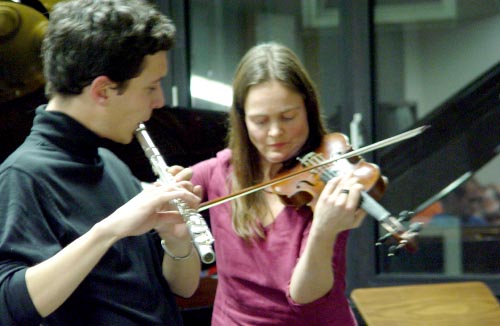
Those guys can play with each other but could the guy ask the girl for her telephone number using only music? Could she answer?
As for communication across cultural boundaries: it is a touchy subject. However music seems to be not as permeable as musicians want to make us believe. Subcultures explicitly use music to SEPARATE themselves from others. Generally speaking, Goths listen to a different music then Punks, Emos, B-Boys, Ravers etc. Here, music helps defining cultural boundaries.
As I mentioned previously, music is great at setting the mood, but this is as far as music can go when it comes to communication. You can communicate something like “despair for the lost of a child”. But you can’t communicate “Honey, would you buy some milk on the way back from work?”. Every musician who tries to do so will drink a lot less milk. But that’s ok, because I probably wouldn’t want to listen to that kind of song anyway. Of course, I talk about music without lyrics. If you add lyrics, music becomes a language but only because language is IN IT.
The consequences for game designers are profound. You can put music in the background to communicate something very general and broad – say, the fast music in Tetris when the rows get very high. But you can’t be as specific with it as you can with text or graphics. So for most games, you can play without music, but you can almost never play them without text or graphics or sound effects. There are some exceptions though, so let’s look at the big picture:
Out of this 3 facts about music, we can create categorize the different uses of music in games.
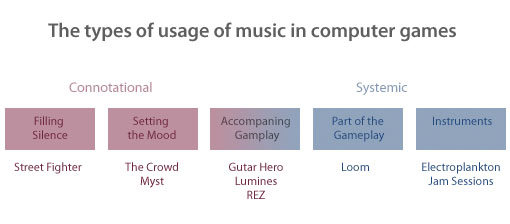
This categorization was put together very quickly and I’m sure it can be improved upon but right now it does a good job to start the discourse. I set up two broad categories of music usage in games. One being “Connonational”, which means that the music doesn’t directly affect the game play and the game can be played with the music turned off. The other is type of usage is “Systemic” which means that there is a deep linkage between the system of music and the system of gameplay and that you loose vital gameplay elements if you turn off the music.
Further, I defined 5 different types of music usage. 4 of them can be categorized as either being Connotational or Systematic. The fifth one is somewhat a transitional type. This reveals that the whole categorization is a very fuzzy thing and there is always something Connotational about Systemic usage and vice versa. Let me say something about the individual types:
Filling Silence
This is the simplest way of implementing music in a game. Select a tune you like, put it in the background, set it to loop. There you go. I’ve mentioned Street Fighter as an example but that isn’t exactly right. Music is so good at setting the mood that removing it will always result in a different game experience. So even in Street Fighter, the music is quick and lively which fits well to the overall playing style. The “Filling Silence” category might be only theoretical. However there are games, which get very close. Many flash games feature really annoying music you almost immediately turn off voluntarily, changing the character of the game in a positive direction. ![]()
Setting Mood
This is about what Music is really great at. That’s why most of the games fall in this category. It is characterized by the use of a very specific piece of music, which fits into the context of the game. Even the simplest games use the music to set the mood in some way. Think of Tetris. It may seem like a case of Filling Silence but there is the special music when you are close to game over and the normal music sounds very Russian which is the overall theme of the game.
I’ve mentioned Myst here because it represents a more sophisticated use of music. Music is very subtle there, used scarcely and in very specific scenes. Myst is generally more a game about mood then Tetris or Street Fighter, so it is a better example.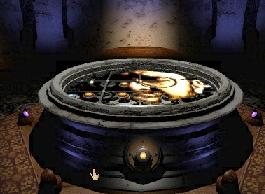
The well-known holoprojector in Myst. When you enter the room (a dark cave), you suddenly hear some very atmospheric music playing.
Accompaning Gamplay
This is the transitional category. A good example is when things happen on the screen in sync with music as in Gutar Hero, Rez or Lumines. In this case, the gameplay as clearly a systemic relation to the gameplay. Somebody must have sat down and actually counted the BPM’s of a song or even designed a whole sequence of Guitar Hero frets, which mirror to some extent the individual notes of the song. But there is some Connotational function there too: the choice of Songs in Gutar Hero is not random. They all help creating the whole rock star fantasy. Right now, this type of usage is a bit underdeveloped but a large chunk of games, which fit into this category are actually an established genre: the rhythm game genre.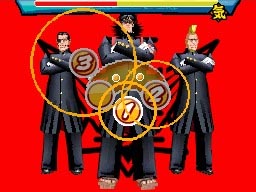
Ouendan is a good example of the plethora of rhythm games, which appeared recently.
Part of Gameplay
And we sail into the undiscovered realm of Systemic use of music. Right now, there are very few games, which work like that and even those that do fit, fall into the category of educational games, which teach kids about music. There is one, shining example, though. It is an old adventure called Loom and it was designed by Brian Moriarty I already mentioned. I will talk about Loom some more at the end of this post. For me, it represents a desirable direction to develop games in.
Instruments
In some new, innovative games the player’s ability to generate music is very well developed. Additionally, those games do not present you clear goals or challenges. As a result, they become more digital instruments or music programs then games. There are very few “games” like that but a good example is Electroplankton which is a fascinating collection of various musical “toys”. It is a great experience, I’d wish I had something like that as a kid because you can do some great stuff with it. This kind of “game” can be only created with a deep understanding of the Systemic properties of music in mind. Also they do not necessarily create a specific mood as they provide no context where that mood would be useful. The different toys in Electroplankton have their unique sounds and styles but this is also true for real instruments and to some extent it is up to the player what sort music comes out.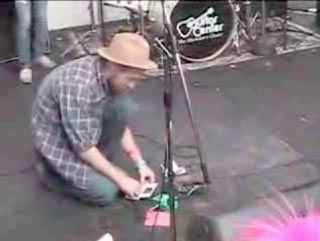
Jam Sessions being played as an actual instument on stage.
Loom
As already said, for me, Loom is the kind of usage of music I would love to experiment in the future. Right now, there are not many examples of music as part of the gameplay. If you do know a game which fits in here, please share it me!
When music becomes part of the gameplay, players have to make music or listen to music in order to proceed. In the case of Loom, this is done by assigning different meanings to certain tunes which players have to remember and reproduce. By doing so, melodies become symbols and therefore transcend the music’s inherit inability of generating meaning by itself. However in this type of usage, music must be very clear and simple so it somewhat awkward if you want to create mood. Yet, Loom is a very old and experimental game and I do believe that some with some research and development it is possible to add some Connotational value to this type of music usage.
Loom is an old-school 2D Point-and-click Lucasarts adventure. You have a character and you can click on things to interact with them. However, Loom is somewhat an oddball. First, there are no Items to pick up in Loom, which is unusual. But more importantly, in other Lucasarts adventures you had a matrix of buttons for different verbs at the bottom of the screen, which you could use to manipulate the environment. In Loom, you just have a wooden stick. It is a magical stick and actually, it is a simple music instrument. Clicking on the different areas on the stick will produce different tones. The idea is that with this stick, you can produce magical tunes which cast spells of different objects. In a way, it is still like the matrix ob buttons but instead of simply clicking a button you have to recall and play a certain tune. You learn new tunes from the environment. Looking at a hatching egg, you will hear the tune for the spell “Open”. Some of the tunes are randomized at the beginning of the game so you are forced to find and remember the tunes even if you play for a second time.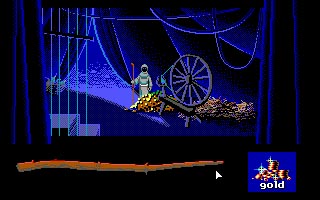
On of the easiest tasks in loom is to turn hay into gold.
This is already a very cool idea but Loom does two things to spice things up even more. First, at the beginning of the game you can play only a few notes. As you proceed and gain more experience, your stick “levels up” giving you access to spells you previously couldn’t play. This gives you a great sense of progress and makes the first levels much easier at the same time.
The second additional idea is that some spells can be reversed by playing them backwards! So playing the “Open” spell backwards is the “Close” spell. Some spells, like “Night Vision” cannot be reversed, because it would make no sense. Here is the kicker: the spells, which aren’t reversible are Palindromes – melodies, which sound the same if you play them backwards! This is just such a great Idea. The actual properties of the melodies naturally define the way the player can interact with them!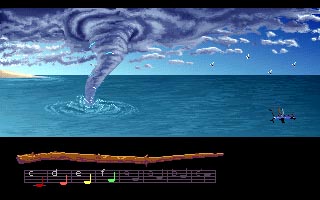
On easier difficulty levels, the game offers some visual help. Here, we are learning the “Twist” spell from a twister.
Loom comes in different difficulty modes. In the easier modes, the stick has different visual cues (colors, notes etc..) , which helps players remember the melodies. You get the full Loom experience in the hard mode, where you have to rely on hearing only. So Loom is another example of how usability works different in games. From the point of view of efficiency, the stick is clearly inferior to the classical button matrix. Players will struggle a lot with remembering and reproducing the different tunes. Yet in the context of the game, it creates an experience no other, efficient interface could.
In Loom, you play a mysterious magician from the guild of Weavers (unique theme!). You wield mystical the power of magic. It would take away all that mystery if a spell was just a button you can press. Instead, you are given a stick, which looks ordinary at first but as you learn the tunes, you discover the great powers that lie within. Using it is hard and difficult but if you make an effort, you can do some great things. One of the first spells in the game turns hay into gold! All the time, the interface stays the same. The the struggle of the player with the interface accurately mirrors the experience of the young magician in the game, learning to utilize the magic staff to its full potential.
Of course, Loom is not perfect and it has its share of shortcomings. The tunes used for spells are very simple and ordinary. This might be because of hardware limitations but also because of sheer usability. Additionally, the tunes themselves have a rather arbitrary connection to what they mean. Although this is a property of a real languages too, it would be interesting if the the spells were a bit more Onomatopoeic. Still, it is a great game with a unique theme, great story, unique use of music and a resulting superb gameplay.






I feel this post is rather the crown jewel of the Round Table this month and there are a tremendous amount of points to follow up on. I think I want to start with the “music is not a language” premise.
Human language (both written and spoken) is essentially an agreement to attach significance to an assembly of sounds and symbols in order to communicate more complex thoughts.
And if the primary use of language is to communicate, who is to say that ‘evolved’ notions such as “pick up milk at the store” need to be possible for something to qualify as language? Biologists often refer animal communication as “language” and to our everyday perceptions, birds’ language is no more (or less) subtle or complex than music and I doubt a bird has ever asked their mate to pick something up at the store.
Additionally, music is totally complex enough to weave codes into. Should a couple decide to assign meaning to various notes, note progressions and chords, it would totally be possible sit down at the piano and make specific shopping requests.
So, let’s argue that for a moment while I go find a copy of Loom to play.
Crown jewel? I’m flattered!
Concerning Human language and other forms of communication: I think we have to separate “communication” and “language”. Obviously, you music is a form of communication. Also, animals also communicate with sound, smell, visual signs and other things. However, human language is very, very special and unique. It is actually the single, most remarkable feature, that sets us humans apart from animals.
As I said, there is a lot of linguistic research on how languages work and what sets them apart from other forms of communication. One person who should be mentioned here is Charles Hockett who developed the so-called Design Features of Language. He identified 16 (!!) features of human language. Every human language satisfies all of them. Some other forms of communication, such as music or various animal communication satisfy some of the 16 but never all of them.
Some of the features are really very specific and basic but the features I find most interesting are the following:
Semanticity – Speech sounds can be linked to specific meanings.
Discreteness – Each unit of communication can be separated and unmistakable.
Productivity – The ability to create new messages by combining already-existing signs.
Displacement – The ability to talk about things that are not physically present.
Reflexiveness – Language can be used to refer to (i.e., describe) itself.
Prevarication – The ability to make false statements (to lie).
Duality of Patterning – Meaningful signs (words) are made of — and distinguished from one another by — meaningless parts (sounds, letters)
The last one is interesting and has more to it then it seems. I’m not sure if I am able to explain it correctly but it is nice to imagine a language which doesn’t have this feature:
If a language had no Patterns at all, we would need a new sound for every meaning. The human voice apparatus is only able to produce around 60 different sounds. Of course, machines can produce much more but at some point it become difficult for the listener to discern the sounds from each other. So most human languages only use about 30 different sounds, which by themselves have no meaning.
If a language had a single Pattern, everything you say would have to be a single sequence of sounds – just one word. So there would be a word for every meaning. So “Honey, would you buy some Milk” would be “XYWZK”. “Honey, would you buy some Bread” would be “ÖOTRE” etc.. . This is basically the language of Loom and it would be the language of our theoretical couple. In Loom, it is ok because we only have just a few verbs to communicate. However, in real life our ability to communicate would be limited to just very common expressions. It would be difficult to express something new … like the Theory of Gravity.
Only because we have this double structure, we can use a limited number of meaningless sounds to produce a limited number of meaningful words to produce an infinite number of meanings, which can be understood by everybody who has mastered the language.
And I love that little fact that only a true language can produce lies. Almost poetic
Dear cousin,
Very nice article. Some very interesting points. I would just like to add two things. Firstly, behind every moment when I “casually walk up to a piano, sit down and spontaneously create a tune which everybody in a room will instantly understand as art” lie hours of months of years of practice. I think this would be common knolwedge. In this respect our fields are quite similar. Secondly, regardless of our definition of language, remember that while music can’t communicate “honey, would you buy some milk on the way back from work?” it can sometimes communicate feelings with much more poignancy, sometimes to the point where a verbal equivalent would turn out embarassingly pale by comparison, or even impossible. That’s what is so wonderful about it.
Just wanted to make sure we understand that music can be more than a mood setter. Outside of computer games of course.
How’s life?
Marcin
Hey Cousin!
Nice to hear from you. Honestly, I never thought you would be reading this. What a pleasant surprise!
As for you comments – of course I don’t deny the status of art to music. I am well aware that making music – especially the kind you do – takes a lifetime of practice and learning.
The problem is more on the other side of the comparison – even today, games are often denied the status of art. This wouldn’t be a problem but the underlying message is that creating games is not recognized as something worthwhile. As you can imagine, this is quite discouraging for people who invest so much working on games.
The ability for music to address feelings in undeniable. But calling this “communication” doesn’t to justice neither to “language” or “music”. Music is poor at transmitting information. Transmitting information is a poor description of what music does. I’d say it would be best to keep the two apart.
And of course, I’m talking only about music in the narrow context of games. I neither have the expertise nor the space to discuss EVERY aspect of music. I’d rather leave that to you.
I enjoyed your post which I found very articulate and attentive to detail.
The claims you make about language (and the subsequent comments) remind me of a few features of language worth mentioning (I can’t remember whether these come from Wittgenstein, Gregory Bateson, or someone else):
- languages allow beings to make reference to objects not physically present.
- languages allow us to differentiate between particular qualities – ie, between the taste of an orange and its color.
- we can indeed only tell lies in language!
The problem with the way that linguists and psychologists deal with language is that communication is only ONE of its properties. Language also allows us to express and constitute experiences in particular ways that are impossible without language, and not simply for the sake of communicating inner states to other people.
That is why I feel partial to both arguments – that music seems to share some properties of languages because it is an expressive practice (as Corvus mentions), yet it does not share many of the communicative/designative/representational properties that Krystian mentions.
And, this is something again missed by most linguists and psychologists, what makes language meaningful and grammatical is its basis in something more foundational: human social practices – Wittgenstein’s “agreements in action”. The only point I’m making here is that language isn’t language because it’s a system of symbols that magically has the Hockett’s 16 properties… a language is a language because it allows us to “step out of” our agreements in action and ask each other the question, ‘What was it we were doing again?’
Anyway, I’m writing way too much here, and getting way too deep into philosophical diatribery. Suffice to say, it’s great seeing someone take a deeper look at music.
And, be sure to read my little article on iMUSE – I wish I had added some clips from Loom! This is one of my favorite games of all time – truly unique and beautiful.
Have you seen my swans?
Hi, I just stumbled upon this post as I occasionally search for entries on the web of what I’m currently developing.
I’m a 3rd year music student in Australia, and I’m actually trying to develop a game as a piece of music. There’s currently alot of research going into having music be this never-ending experiential thing, but I say bollocks to that.
I think that many great games have a linear structure – a beginning, middle and end. I think applying this structure of a game to build a piece of music whereby simple gameplay objectives create the music is something like a musical instrument being its own piece of music.
Anyway I have many thoughts but nothing concrete to back it up. I’m halfway through the final prototype development – level 2 out of 4 levels. I’m coding in AS3, and I’ll be sure to let you know once I’m done.
In the meantime, are there any resources on this avenue of interest that you might recommend?
@Luke
Your idea sounds very interesting to me.
I don’t have any noteworthy musical skills or talents, though I also have been thinking about another type of music/rhythm based game where it is not only about you “activating” the right sound at the right time, but using the game – as you said – more like an instrument.
I also tried this in AS3 but had to realize that playing sounds on keypresses isn’t consistently in rhythm enough for what I had in mind.
If you have satisfactory results in this regard, would you care to share some pointers with me?
Well there’s a few different things you could do – if you want keypresses to be locked into a beat, I wouldn’t cue the sound from the keypresses.
Create a timer which pulses at a regular tempo, say four times a second. In BPM, this would be 240bpm. This timer would run a function checking to see if a key had been pressed in the last interval – if true, then a sound would be triggered by the Timer, still in time with an overall beat.
Of course, this isn’t always accurate – it’s only as accurate as the computer is fast, but I’ve had success in creating pieces in the style of a guy named Steve Reich – look him up.
For more specific stuff, is there any way to email each other?
Hi Luke,
thanks for the quick response.
I’m aware of that workaround, which is OK for the typical rhythm-based game: press in sync and you’ll activate the right sounds, otherwise you miss it completely.
Unfortunately it doesn’t help me.
What I’m trying to do is something like virtual drums. Your key presses always make sounds, it’s up to you to make a rhythm. BPM is whatever you make the beats to be.
The goal is to have the “level” make you create a song. Imagine Rez, but instead of activating more and more tracks within a song, how you interact with the enemies makes the song.
I don’t know yet if this makes sense at all, but that’s also the reason why I want to prototype it. Too bad AS3 still sucks at sounds.
But yeah, this is not the place for AS3 discussion.
Please write me at
[my last name (four letter)]
@
[k]öln
[i]nternational
[s]chool of
[d]esign
.
[de]